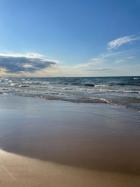Learn about the latest news and consider subscribing.
News and Updates
Recent News
EPA to Hold Virtual Public Engagement Session on Great Lakes Restoration Initiative Action Plan
Gathering public input is a key part of the process to develop the action plan.
August 18, 2023
Great Lakes Piping Plovers StoryMap: a new tool to engage the public on Piping Plover conservation in the Great Lakes
Developed in collaboration with Audobon Great Lakes, the interactive site will be used for education and outreach and includes several GLRI-supported recovery efforts.
August 11, 2023
U.S. Army Corps of Engineers Takes Next Step to Create New Wetland Ecosystem in Buffalo’s Outer Harbor
Construction of the stone breakwater in Buffalo’s Outer Harbor marks the first major physical step in creating another new wetland ecosystem on Buffalo’s waterfront using material dredged from the Buffalo River.
August 10, 2023
$3.2 Million Recommended for Great Lakes Habitat Restoration
Funding for two ongoing and two new cooperative agreements will support habitat restoration efforts that strengthen Great Lakes fisheries, ecosystems, and communities.
August 3, 2023
Captive-reared Great Lakes piping plovers released at Montrose Beach
U.S. Fish and Wildlife Service and partners celebrate the release of federally endangered piping plover chicks back into the wild at Montrose Beach in Chicago, Illinois.
July 31, 2023
A Door County Dairy Farm Committed To Conservation
Fourth-generation farmers and owners of Brey Cycle Farm in Door County highlight the environmental and financial benefits of conservation practices that improve soil health and protect water quality.
July 17, 2023
Loss of Fish and Wildlife Habitat and Degradation of Fish and Wildlife Populations BUIs removed at Muskegon Lake AOC
After implementing an extensive shoreline and wetland habitat restoration plan in Muskegon Lake and portions of its tributaries, the Loss of Fish and Wildlife Habitat and Degradation of Fish and Wildlife Populations Beneficial Use Impairments have been removed from the Muskegon Lake Area of Concern. There are two remaining BUIs in this AOC.
June 14, 2023
Tribe restores beetle-plagued forest
With funding from the GLRI through the USDA Forest Service, the Saint Regis Mohawk Tribe removed ash trees plagued by emerald ash borer and replaced them with a diverse selection of trees to restore a forest in upstate New York.
May 19, 2023
Bridging the Crystal River: For fish, for people, and for a free-flowing river
The Grand Traverse Band of Ottawa and Chippewa Indians and partners target problematic road-stream crossings on the Crystal River, restoring connection for aquatic species.
May 2, 2023
National Fish and Wildlife Foundation Announces $1.7 Million in Conservation Grants to Improve Community and Habitat Resilience in Southeast Michigan
Public-private partnership funds six projects to improve water quality, enhance habitat, and increase accessibility to public green space.
May 2, 2023










